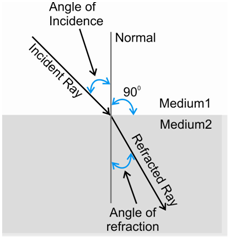Refraction:
When a beam of light travelling through air falls on glass at an angle, it abruptly changes its direction or in simple words, it bends. A same effect is observed while the light emerges back into air after passing through the glass. In common, when a radiation falls on the interface of two transparent media of different densities, it abruptly changes its direction. This is known as refraction of the radiation. Refraction is a consequence of the difference in the velocity of radiation in the two media. When the radiation passes from a rarer medium (say air) to a denser medium (say glass) it bends towards the normal to the interface. If the sequence of the media is reversed then it bends away from the normal to the interface at the point of incidence. The process of refraction in case of radiation passing from rarer to a denser medium can be depicted diagrammatically as shown in Figure.

Figure: Phenomenon of refraction of radiation
According to Snell's law:
sin θ1/sin θ 2 = η 2/η1 = v1/v2
where, θ1 and θ2, are the angle of incidence between the incident ray and the normal and the angle of refraction between the refracted ray and the normal, respectively. η1 and η2 are the refractive indices of the medium that the light is entering into and leaving (or entering from) respectively; v1 and v2 correspond to the velocities of light in medium 1 and 2, correspondingly.